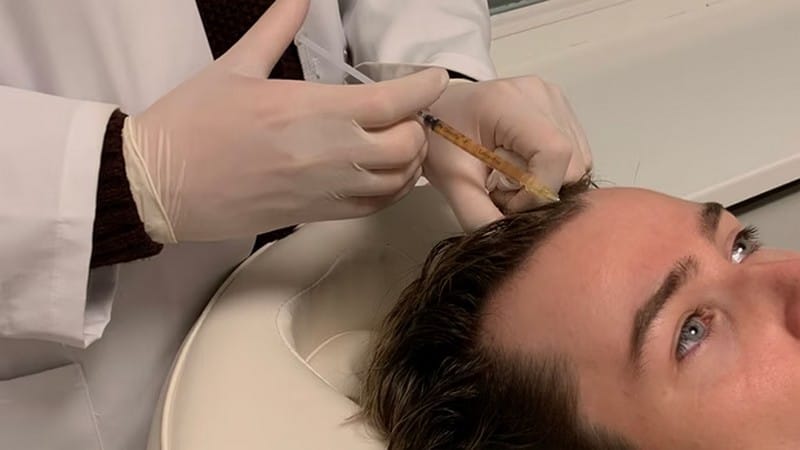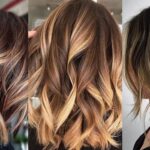- Share
- Like
- Del
- Tumblr
- VKontakte
- Buffer
- Love This
- Odnoklassniki
- Meneame
- Blogger
- Amazon
- Yahoo Mail
- AOL
- Newsvine
- HackerNews
- Evernote
- MySpace
- Viadeo
- Line
- Comments
- Yummly
- SMS
- Viber
- Telegram
- Subscribe
- Skype
- Facebook Messenger
- Kakao
- LiveJournal
- Yammer
- Edgar
- Fintel
- Mix
- Instapaper
If you lose your hair, can only a transplant help? No, a new method promises full hair thanks to autologous blood injections. Here’s how it works:
Have you ever read about the vampire lift?
Blood is taken and then injected under the skin. What sounds gruesomely painful is considered by Hollywood stars to be a guarantee of a very young complexion. That’s why the treatment is discussed up and down in the tabloid press. But hardly anyone writes about this: autologous blood therapy also helps against hair loss.
OLhairstyles.com spoke to the Hamburg aesthetic medicine doctor Jorge Castaneda MD from the renowned beauty practice Docboom about the treatment and tried it out directly. You can read here whether the treatment worked, how exactly it works, and what risks the bloody procedure poses.
What is PRP or PRF hair loss treatment?
PRP is the short form for the English term “platelet-rich plasma.”. “Platelets contain growth factors that stimulate cell renewal, regeneration, and collagen synthesis,” explains Jorge Castaneda, adding: “In the treatment against hair loss, only the plasma, i.e., the part of the blood that is particularly rich in platelets, is injected using fine needles injected into the scalp, exactly where the hair is thinning.” Unlike a hair transplant, which you can read more about here, there is no cutting.
The further developed version, i-PRF, is still completely new in Germany. This stands for injectable platelet-rich fibrin. The difference: “Due to a different manufacturing process, the body’s stem cells are included, and the concentration of platelets removed can be up to ten times higher than with PRP. In addition, the growth factors are released over a longer period,” says Castaneda. The treatment is considered more effective and is currently only offered by a few doctors.
How does autologous blood treatment work?
The growth factors intensively stimulate the formation of tiny blood vessels around the hair roots, so that they are better supplied with nutrients again. Hair growth is stimulated. Jorge Castaneda’s trick: “To increase the effect, mesotherapy can be carried out afterward. Using micro-injections, vitamins and minerals are transported to the middle layer of the skin (‘meson = middle),” explains Castaneda. By the way, we have already tested the Meso process for the face. Here, you will find everything you need to know about mesotherapy.

When does autologous blood therapy for hair make sense?
Have you had a completely bald head for years? Then autologous blood therapy is unfortunately ineffective. However, if the hair is slowly thinning, the method may be suitable. It doesn’t matter why your hair falls out—whether it’s genes or stress that’s to blame.
“PRP and PRF are suitable for diffuse, androgenetic, and circular hair loss. The treatment generally works better for men than for women. However, the prerequisite is that there is still hair present, as the growth factors contained in the plasma stimulate cell renewal Stimulate the hair roots,” says Jorge Castaneda.
How often can and should you do autologous blood therapy?
Experts disagree about how often the treatment should be carried out to permanently stop hair loss and stimulate growth. Jorge Castaneda recommends about three treatments, each one month apart. To maintain success, the treatment should be repeated once a year.
How does autologous blood therapy for hair work?
Our grooming editor, Philipp Wehsack, 30, tested the treatment at Docboom. Here comes his experience report
For about a year now, I’ve noticed that my receding hairline is getting a little bigger. A small birthmark that was previously covered by hair tells me: There used to be more hair here. It’s time to do something. I arranged a consultation appointment with Docboom in Hamburg. The treating doctor first looks at the initial situation and confirms my suspicion: “You can see that the hairline is slowly receding a little. However, it is still in the early stages. Because there is still a lot of baby hair growing.” That makes me the perfect test candidate. “There must still be active hair roots in the affected area for PRF treatment to be effective,” explains the expert.
So you can get started. To get the plasma, a small amount of blood (around 20 ml) is first drawn from the vein, centrifuged, and then specially prepared. What remains is a golden-yellow serum containing the platelets, which are crucial for the success of the treatment, and thus the growth hormones. The doctor injects the liquid into the scalp using a fine needle.

The beauty expert then works on my scalp with a small needle stamp (mesopen). This creates countless microscopic punctures in the scalp, which is, by the way, the reason for the blood-smeared celebrity selfies of women who have tested the treatment on their faces. Things are a little different on the scalp. The puncture sites after treatment can only be seen if you look closely. So I’m immediately socially acceptable again.
The question remains: Doesn’t that hurt? A little bit. But laughing gas or anesthetic injections make the half-hour session with countless pricks bearable. I had a slight headache on two subsequent days. A normal side effect, as the doctor explained to me in advance. Painkillers are allowed and can be used immediately.

Philipp’s conclusion: The PRF treatment works
In total, I have to go through three sessions, four weeks apart. About 1 ½ months after the first treatment, i.e., 14 days after the second session, I realized: it worked! Lots of baby hair grows along the hairline. And the receding hairline? They seem to be getting smaller.
I’m excited. Expert Castaneda says, “This is just the beginning. The result will be visible after about 6 months. Then you should repeat the treatment once a year.” I’ll stay tuned and update this article with more before and after photos as soon as anything changes.
Update after one year: PRF treatment’s long-term effect
A month ago, I had my first refresher treatment with Jorge Castaneda. The doctor confirms my impression: “The hair has become visibly fuller, and baby hairs are growing everywhere.” This is particularly noticeable on the receding hairline, but also on the top of my head; although my hair was already quite full there before the treatment, it is now much fuller. Overall, the hair not only looks more voluminous but also healthier. They shine, and they feel strengthened. Photo evidence can be found in the gallery.
PRF treatment in the test: This is how much fuller the hair is after a year
And what does science say about it?
An Italian study in Padua tested conventional PRP therapy on 1033 patients with androgenetic diffuse hair loss and confirmed an increase in hair density in 80% of the subjects. In 93% of cases, there was an increase in hair thickness. 335 patients with circular hair loss after previously unsuccessful other therapies were also tested. The response rate here was 63%. If you’re interested, here’s everything else you need to know about hair loss.
Are there risks and side effects of autologous blood therapy?
“There are no serious risks with PRF or PRP therapy because they are substances produced by the body,” says Dr. Castaneda, however, adding: “In principle, the possible side effects of treatment with injections must be explained. These include hematomas, infections, or irritations of the skin nerves. And in the case of acute inflammation of the scalp, infectious diseases, and blood clotting disorders, you should avoid treatment.”
How much does autologous blood treatment for hair loss cost?
The whole thing isn’t cheap. At Docboom, it costs 259 euros. Money that you have to raise entirely yourself. The health insurance companies usually don’t pay.
Autologous blood therapy for hair loss is an investment, but one that pays off in most cases. For anyone who has been thinking about a transplant for a long time, autologous blood treatment is a cheaper alternative that is almost painless and has no side effects.
- Share
- Like
- Del
- Tumblr
- VKontakte
- Buffer
- Love This
- Odnoklassniki
- Meneame
- Blogger
- Amazon
- Yahoo Mail
- AOL
- Newsvine
- HackerNews
- Evernote
- MySpace
- Viadeo
- Line
- Comments
- Yummly
- SMS
- Viber
- Telegram
- Subscribe
- Skype
- Facebook Messenger
- Kakao
- LiveJournal
- Yammer
- Edgar
- Fintel
- Mix
- Instapaper






